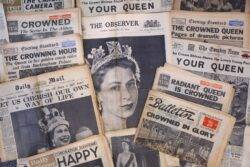Queen Elizabeth II’s coronation on June 2, 1953, was the first wan to be televised (Picture: Reuters)
On what was a cold day for early June, crowds gathered in London in hope of catching a glimpse of Queen Elizabeth as she journeyed to her coronation.
As rain poured down, people huddled – some even fixing their makeup – ahead of the ceremony at Westminster Abbey, which has remained practically unchanged for almost 1,000 years.
What the nation did not know at the time is that her reign – after the death of her father, King George VI – will be the longest in British history.
As her eldest child, Charles, prepares to find out if indeed, heavy is the head that wears the crown, Metro.co.uk looks back at what the last coronation looked like – and why it took some 14 months to plan.
Crowds in the rain in Trafalgar Square watching the troops march past (Picture: PA)
The Royal Coach, carrying Queen Elizabeth II and the Duke of Edinburgh, photographed from the Citadel at the end of the Mall (Picture: Getty)
Thousands of people lined the route of the coronation procession in central London (Picture: Getty)
Queen Elizabeth II, flanked by the Bishop of Durham and the Bishop of Bath, arriving at Westminster Abbey with her six Maids-of-Honour (Picture: PA)
What happened on the day of Queen Elizabeth II’s coronation?
Taking place on Tuesday, June 2, 1953, it began at 11.15am, lasting almost three hours, according to the Royal Family website.
Accompanied by Prince Philip, the Queen arrived in the Gold State Coach, which has been used at every coronation since 1831.
She reached the nave by 11.20am, at which point the hymn I Am Glad was sung.
The monarch then sat in the Coronation Chair, called St Edward’s Chair, for much of the ceremony.
Queen Elizabeth II wearing the St Edward Crown and carrying the sceptre and the rod after her coronation in Westminster Abbey (Picture: PA)
The Duke of Edinburgh paying homage to his wife during her coronation (Picture: PA)
This was the view as seen by television viewers immediately after the Archbishop of Canterbury, Dr Geoffrey Fisher, had placed the Crown upon the Queen’s head (Picture: PA)
Her dress was made up of more than 100 objects of incalculable cultural, historical and symbolic value and featuring in excess of 23,000 gemstones (Picture: PA)
St Edward’s Crown was then placed on her head at 12.34pm, as per the Abbey’s records.
She was given the orb, sceptre, and a Coronation Ring was placed on her right hand.
Just before 3pm, the Queen and Prince Philip travelled from the Abbey, again in the Gold State Coach, back to Buckingham Palace.
They arrived at 4.30pm, and soon after she waved to the cheering crowds from the balcony, alongside members of the Royal Family.
What did Her Majesty wear?
On the journey there, the Queen wore the State Diadem – a circlet of diamonds, which she went on to wear for the State Opening of Parliament throughout her reign.
The St Edwards Crown was used to crown Her Majesty at the service, but she wore The Imperial State Crown on her departure from the Abbey.
Her dress was made by Norman Hartnell, who had designed her wedding dress as well.
The monarch leaving her State Coach and making her way into Westminster Abbey (Picture: PA)
Prince Charles, standing between the Queen Mother and Princess Margaret, disappearing for a moment behind the canopied stand (Picture: PA)
Queen Elizabeth II and the Duke of Edinburgh waving at the crowds (Picture: Getty Images)
The couple with son Prince Charles and daughter Princess Anne and other members of the Royal Family and guests at Buckingham Palace on return from the coronation ceremony (Picture: PA)
It was of white satin with silk embroidered emblems – a rose for England, thistle for Scotland, leek for Wales, shamrock for Ireland, lotus for Ceylon, protea for South Africa, wattle for Australia, wheat and jute for Pakistan, maple leaf for Canada and fern for New Zealand.
Since her coronation, the Queen wore the dress six times including the Opening of Parliament in New Zealand and Australia in 1954.
Meanwhile, the Duke of Edinburgh was in a full Naval uniform for the journey to and from the Abbey.
While inside, he wore a coronet and his Duke’s robe over his uniform.
Who attended the coronation?
To reflect Britain’s high ranking as a world power, a total of 8,251 guests attended the Abbey, including 26 members of foreign royal families.
Following his mother’s footsteps, King Charles III will be the 40th monarch to be crowned there.
It was the first coronation to be broadcasted live on TV, and 27 million people in the country – out of a population of 36 million – watched the event, while at least 11 million more listened on the radio.
It was a breakthrough for the history of broadcasting and for most people, it was the first time they had watched an event on the screens.
Meanwhile, there were more than 2,000 journalists and 500 photographers from 92 nations on the coronation route.
Many royal fans camped in The Mall to see the procession, including a family who had sailed all the way from Australia in a ketch for the occasion.
Thousands more celebrated throughout the country and the Commonwealth with street parties.
Get in touch with our news team by emailing us at webnews@metro.co.uk.
For more stories like this, check our news page.
Heavy is the head that wears the crown.





